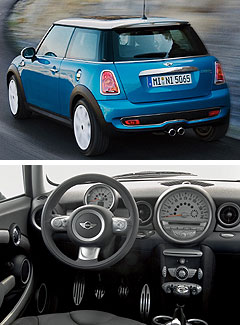Future models - Mini - HatchNew Mini: leaner, cleaner, sexierSpritely: Redesigned Cooper S weighs 10kg less, offers up to 40Nm more. BMW reveals full details of its all-new Mini Cooper range, due to debut here in March15 Aug 2006 By MARTON PETTENDY and TERRY MARTIN BMW has released further details on its forthcoming new-generation Mini Cooper and Cooper S, which will be revealed at the Melbourne International Motor Show in March. On sale in Europe from late this year, the all-new three-door Mini Cooper and Cooper S hatches feature longer new exteriors and more powerful new 1.6-litre four-cylinder naturally-aspirated and turbocharged engines that are also cleaner and more fuel-efficient. Compared to the current car, which was launched globally in 2001 and has found 800,000 homes in the five years since then, the new Mini is 5mm narrower and 1mm lower, while overall length stretches 60mm on the Cooper (to 3699mm) and 61mm on the Cooper S (to 3714mm).  The round, clear-glass headlights are now fixed to the body and have been turned slightly to the outside to maintain the geometry of the car from the front. The indicators, formerly isolated in the front valance, are now housed within the main headlight units. The round, clear-glass headlights are now fixed to the body and have been turned slightly to the outside to maintain the geometry of the car from the front. The indicators, formerly isolated in the front valance, are now housed within the main headlight units.The Cooper S bonnet's front-end is about 20mm higher to house the tubocharger, while the shoulder line on both variants is 18mm higher than before. The result is a drag coefficient of 0.33Cd (0.35 on the previous model). Cooper's new interior remains dominated by a large central speedo, below which is a slimmer centre console, while the ignition key is now a round signal sensor that's inserted into a slot beside the steering wheel to start/stop the engine. The wheelbase remains the same 2467mm but both models now have a 1mm wider front track (1459mm Cooper, 1453mm Cooper S) and rear track (1467mm Cooper, 1461mm Cooper S). It is also lighter, with unladen weight down 10kg to 1065/1140kg for the manual/auto Cooper and to 1130/1205kg for the manual/auto Cooper S. Performance of the new 16-valve Valvetronic engine is 88kW (up 3kW) at 6000rpm and 160Nm at 4250rpm (up 10Nm, at 250 fewer revs) for the Cooper, and 128kW at 5500rpm (up 3kW at 500 fewer revs) and 240Nm (up 20Nm) between a wider 1600-5000rpm rev-range (was 1600-4000rpm) for the turbocharged and direct-injection Cooper S. The S will also have an overboost feature allowing and extra 20Nm of peak torque (260Nm) between 1700rpm and 4500rpm. Acceleration (0-100km/h) remains 9.1 seconds for the Cooper manual (now six-speed), but the S is one-tenth quicker to 100km/h at 7.1 seconds. Biggest performance news, therefore, is Mini's extra in-gear flexibility, with Cooper now covering 80-120km/h overtaking chores in 9.4 seconds (fourth gear), 12.1 seconds (fifth gear) and 14.3 seconds (sixth gear), compared to the current five-speed manual Cooper's 10.5 seconds (fourth) and 13.5 seconds (fifth). Simililarly, Cooper S is also more flexibility, and now completes the 80-120km/h dash in 5.5 seconds (fourth - was 6.1), 7.0 seconds (fifth - was 7.7) and 8.0 seconds (sixth - was 10.5). Average fuel consumption is 5.8L/100km for the Cooper manual (was 6.9L/100km) and 6.9L/100km for the Cooper S (was 8.6L/100km). Despite the power increase, exhaust emissions are also down - from 166 to 139g/km for Cooper manual and from 207 to 164g/km for Cooper S manual. A six-speed automatic - with steering wheel-mounted shift paddles - will be available on both models. Front disc brake diameter increases 4mm on Cooper (to 280mm) and 18mm on the S (to 294mm), while rear discs remain at 259mm on both models. Brake assist and hill-start assist are also new. The new Mini's engines will be produced at Hams Hall, while body panels will come from Swindon before assembly takes place at BMW's Oxford plant in a UK factory reshuffle. Oxford's capacity will be ramped up to 240,000 vehicles annually by 2008 - more than double the planned capacity prior to 2001. A 70kW 1.4-litre Mini One entry-level variant will be released in the UK in 2007, but is unlikely to be made available when the new Mini is released in Australia in the third quarter of next year. All future models Alfa Romeo Alfa Romeo Abarth Abarth Audi Audi Aston Martin Aston Martin BMW BMW Bentley Bentley Chrysler Chrysler Chevrolet Chevrolet Dodge Dodge Citroen Citroen Ferrari Ferrari DS DS Ford Ford Fiat Fiat FPV FPV Foton Foton Haval Haval Great Wall Great Wall Honda Honda Holden Holden Hyundai Hyundai HSV HSV Isuzu Isuzu Infiniti Infiniti Jeep Jeep Jaguar Jaguar Lamborghini Lamborghini Kia Kia Lexus Lexus Land Rover Land Rover Mazda Mazda Maserati Maserati Mercedes-Benz Mercedes-Benz McLaren McLaren Mini Mini Nissan Nissan Mitsubishi Mitsubishi Peugeot Peugeot Opel Opel Proton Proton Porsche Porsche Renault Renault Ram Ram Saab Saab Rolls-Royce Rolls-Royce Smart Smart Skoda Skoda Subaru Subaru SsangYong SsangYong Tesla Tesla Suzuki Suzuki Toyota Toyota Volvo VolvoHatch pricing
Motor industry news |
Click to shareMini modelsAll future models Alfa Romeo Alfa Romeo Abarth Abarth Audi Audi Aston Martin Aston Martin BMW BMW Bentley Bentley Chrysler Chrysler Chevrolet Chevrolet Dodge Dodge Citroen Citroen Ferrari Ferrari DS DS Ford Ford Fiat Fiat FPV FPV Foton Foton Haval Haval Great Wall Great Wall Honda Honda Holden Holden Hyundai Hyundai HSV HSV Isuzu Isuzu Infiniti Infiniti Jeep Jeep Jaguar Jaguar Lamborghini Lamborghini Kia Kia Lexus Lexus Land Rover Land Rover Mazda Mazda Maserati Maserati Mercedes-Benz Mercedes-Benz McLaren McLaren Mini Mini Nissan Nissan Mitsubishi Mitsubishi Peugeot Peugeot Opel Opel Proton Proton Porsche Porsche Renault Renault Ram Ram Saab Saab Rolls-Royce Rolls-Royce Smart Smart Skoda Skoda Subaru Subaru SsangYong SsangYong Tesla Tesla Suzuki Suzuki Toyota Toyota Volvo VolvoHatch pricing
Motor industry news |














Facebook Twitter Instagram